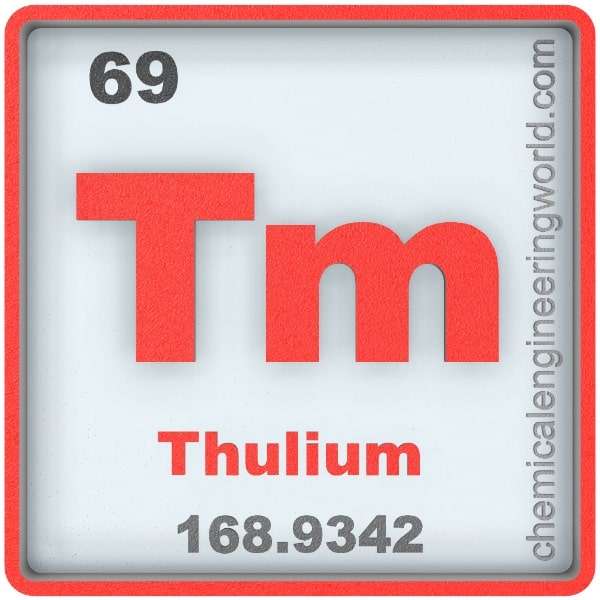Thulium Element Properties and Information

Thulium Element Properties and Information
Thulium is 69th element on the periodic table. Elements are arranged in the periodic table on the basis of the atomic number. Atomic number is the number of protons in the nucleus of the atom. Thulium has an atomic number of 69. It is located in the Group ‘Lanthanides’ and Period 6 of the periodic table of elements. It is denoted by ‘Tm’. It is named after Thule, ancient name of Scandinavia.
The discovery of Yttrium in 1794 paved the way for discovery of many other similar elements which were later termed as lanthanides. Erbium was one such element which was obtained by investigation of contaminated yttrium in 1843. Per Teodor Cleve observed that the atomic weight of erbium varied w.r.t its source of extraction, thus he reasoned that it must contain a new element. He obtained Thulium from it in 1879. Theodore William Richards obtained pure sample of thulium in 1911 by performing 15000 recrystallisations of thulium bromated.
Thulium is never found in nature as a free element. Its concentration in Earth’s crust is 0.5 ppm. Thulium is mainly extracted from monazite minerals, wherein its concentration is about 20 ppm.
Physical Properties
- Bright & silvery thulium is the third-last element in the lanthanide series.
- The atomic mass of thulium is 168.93.
- The melting point of thulium is 1545°C.
- The boiling point of thulium is 1947°C.
- The density of thulium is 9300 in S.I. units at 20°C.
- Thulium metal can be cut with a knife.
- Below 32K, thulium is ferromagnetic in nature. Between 32-56K thulium is antiferromagnetic. Above 56K, it becomes paramagnetic.
- The isotopes of thulium range from thulium-145 to thulium-179.
Chemical Properties
- Thulium gradually tarnishes when exposed to air.
- Thulium burns readily in air at 150°C to form thulium(III) oxide.
- Thulium reacts with water to form thulium hydroxide. It reacts slowly with cold-water and faster with hot-water.
- Thulium reacts with all halogens to form the corresponding trihalides. Its reaction is slow at room temperature and much vigorous at 200°C.
Methods of Production
From Monazite Ores: The crushed ore is treated with hot-concentrated sulphuric acid to get dissolved sulfates of lanthanides. The acid filter is neutralized using sodium hydroxide at pH 3-4, during this process; the thorium gets removed as a hydroxide. The solution is then treated with ammonium oxalates to get lanthanide oxalates. The oxalates are converted to oxides by annealing. The thulium metal is obtained by reducing thulium oxide with lanthanum.
Relevance in Chemical and Related Industries
Non-destructive testing: Thulium-170 is one of the most popular sources for industrial radiography.
Relevance in Other Industries
Lasers: Holmium-chromium-thulium triple-doped yttrium aluminum garnet is an active laser medium material with high efficiency.
Health Effects on Exposure
Toxicity: In-soluble thulium salts are completely non-toxic but soluble thulium salts are completely toxic if taken in large amounts.
Effects on Surroundings
Thulium poses no harm to plants, animals, and environment.
References:
https://en.wikipedia.org/wiki/Thulium
































